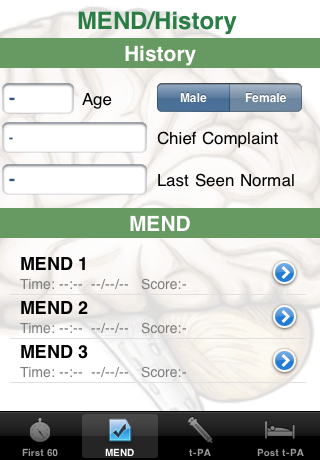
The Miami Emergency Neurologic Deficit (MEND) examination is a focused neurologic assessment tool to aid healthcare providers in rapid identification and initial management of patients with stroke. The exam incorporates the Cincinnati Prehospital Stroke Scale (CPSS), and has additional components from the NIH Stroke Scale (NIHSS).
The MEND Hospital (Hosp) application helps hospital providers to detect and manage stroke patients. The application is divided into tabs that allow the user to navigate the following: the first 60 minutes of caring for an acute stroke patient; the MEND exam with sequential scores for monitoring; t-PA indications and contraindications for the 3-hour and 4.5-hour windows; t-PA dosing; and post-t-PA care. Users are prompted to indicate whether there is a new patient, or whether they wish to resume entering information on an existing patient.
The MEND exam was developed by a national consortium of stroke neurologists, emergency physicians, neuroscience nurses, and paramedics. In the hospital environment, the MEND exam has been used by nurses as their initial and monitoring neurologic examination for stroke patients. Although the exam incorporates the CPSS and additional components of the NIHSS, it can be completed in less than 3 minutes and does not require additional equipment. It is scored on a scale of 0-22.
The NIHSS must be completed by the stroke team upon patient presentation and prior to the administration of t-PA, as well as at regular intervals. The MEND exam can be used by nurses to perform frequent neurologic examinations in the emergency department, stroke care unit, or floor. The MEND exam is taught as part of a comprehensive stroke curriculum, Advanced Stroke Life Support.
The application has the following components:
-First 60 Minutes
-Lists all of the components that must be completed prior to IV t-PA administration, with a timeline. Additionally, guidelines for management of HTN and t-PA dosing are provided.
-History/MEND
- The patient’s history, including age, sex, chief complaint, and time last seen normal, is recorded. The components of the MEND exam are provided in a checklist format and automatically scored from 0-22; up to 3 sequential MEND scores are recorded.
-IV t-PA Indications and Contraindications
-The indications and contraindications for IV t-PA for both the 3-hour and 4.5-hour windows are listed with yes/no checkboxes. Relative contraindications/precautions are also listed. Green, yellow and red colors are used to guide the practitioner to go ahead, slow down and consider the precaution, or to stop due to a contraindication.
-Post t-PA
-Patient care following IV t-PA is summarized here, including general considerations, close monitoring and BP management, and complication prevention.


